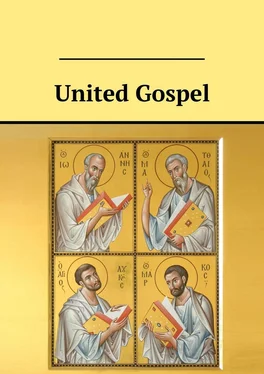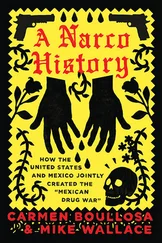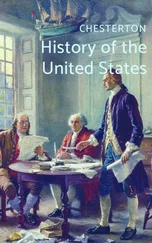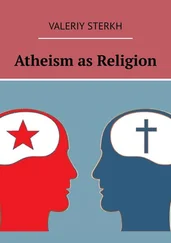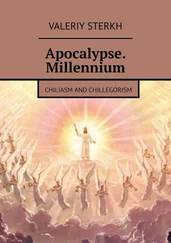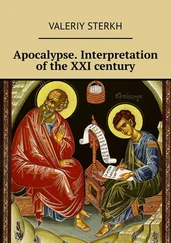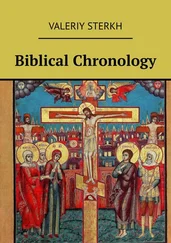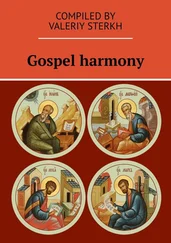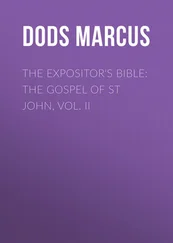Valeriy Sterkh - United Gospel
Здесь есть возможность читать онлайн «Valeriy Sterkh - United Gospel» — ознакомительный отрывок электронной книги совершенно бесплатно, а после прочтения отрывка купить полную версию. В некоторых случаях можно слушать аудио, скачать через торрент в формате fb2 и присутствует краткое содержание. ISBN: , Жанр: Прочая документальная литература, Религиозная литература, Религиоведение, на английском языке. Описание произведения, (предисловие) а так же отзывы посетителей доступны на портале библиотеки ЛибКат.
- Название:United Gospel
- Автор:
- Жанр:
- Год:неизвестен
- ISBN:9785449014467
- Рейтинг книги:4 / 5. Голосов: 1
-
Избранное:Добавить в избранное
- Отзывы:
-
Ваша оценка:
- 80
- 1
- 2
- 3
- 4
- 5
United Gospel: краткое содержание, описание и аннотация
Предлагаем к чтению аннотацию, описание, краткое содержание или предисловие (зависит от того, что написал сам автор книги «United Gospel»). Если вы не нашли необходимую информацию о книге — напишите в комментариях, мы постараемся отыскать её.
United Gospel — читать онлайн ознакомительный отрывок
Ниже представлен текст книги, разбитый по страницам. Система сохранения места последней прочитанной страницы, позволяет с удобством читать онлайн бесплатно книгу «United Gospel», без необходимости каждый раз заново искать на чём Вы остановились. Поставьте закладку, и сможете в любой момент перейти на страницу, на которой закончили чтение.
Интервал:
Закладка:
United Gospel
Translator Valeriy Sterkh
Составитель Valeriy Sterkh
© Valeriy Sterkh, translation, 2021
ISBN 978-5-4490-1446-7
Created with Ridero smart publishing system
Author’s note
This work is an experiment in connecting the four canonical Gospels into one narrative. The content of the work consists only of words and phrases found in the four Gospels; consequently the resulting text is entirely assembled from the canonical Gospels of Matthew, Mark, Luke and John. Hence its name: “United Gospel”. As a source material, we have used the King James Version of the Bible. In some cases, explanatory words were added for clarity, even though they are not found in the King James Version; such words are in brackets.
To align the four Gospels, the tables of synoptic parallels were used. The alignment was based on the Gospel Synopsis from the Orthodox Bible, which reproduces a related publication of the Moscow Patriarchate (Bible. Moscow: Russian Bible Society, 2000) In some cases, the comparison was made based the table borrowed from the Belgian edition of the Holy Scriptures (Bible. Brussels: Life with God, 1983). It is worth noting that, for the goals mentioned above, none of the two tables were acceptable “as is”, for a number of reasons. In this respect, the interpretation of the Gospel narrative about the resurrection of Jesus Christ proved to be the most critical. To solve the apparent conflict, we have used the sequence from the Harmony of the Gospels, quoted in Seraphim Slobodsky’s “The Law of God” (“The Law of God for Families and Schools”. Jordanville: Holy Trinity Monastery, 1967). Based on the analysis of the above mentioned sources, a new table of synoptic parallels was created according to which the following “United Gospel” was drafted.
While working on the “United Gospel”, the issue of chronology was something we could not ignore. This meant not only determining the order of certain events but also their dating. To solve problem with a satisfactory result, we had to made chonological calculations all over again. Such a complex approach to dating of the Gospel events also helped to clarify a number of theological issues and resolve certain problems related to the New Testament Bible studies. For instance, it was clearly seen that Lk 6:1 talks about Pentecost, not Easter.
The above mentioned calculations with commentaries can be found in my book “Biblical Chronology”.
United Gospel
UG 1. Prologue (Mk 1:1; Lk 1:1—4; Jn 1:1—18)
1:1 Forasmuch as many have taken in hand to set forth in order a declaration of those things which are most surely believed among us, (Lk 1:1)
1:2 Even as they delivered them unto us, which from the beginning were eyewitnesses, and ministers of the word; (Lk 1:2)
1:3 It seemed good to me also, having had perfect understanding of all things from the very first, to write unto thee in order, most excellent Theophilus, (Lk 1:3)
1:4 That thou mightest know the certainty of those things, wherein thou hast been instructed. (Lk 1:4)
1:5 The beginning of the gospel of Jesus Christ, the Son of God. (Mk 1:1)
1:6 In the beginning was the Word, and the Word was with God, and the Word was God. (Jn 1:1)
1:7 The same was in the beginning with God. (Jn 1:2)
1:8 All things were made by him; and without him was not any thing made that was made. (Jn 1:3)
1:9 In him was life; and the life was the light of men. (Jn 1:4)
1:10 And the light shineth in darkness; and the darkness comprehended it not. (Jn 1:5)
1:11 There was a man sent from God, whose name was John. (Jn 1:6)
1:12 The same came for a witness, to bear witness of the Light, that all men through him might believe. (Jn 1:7)
1:13 He was not that Light, but was sent to bear witness of that Light. (Jn 1:8)
1:14 That was the true Light, which lighteth every man that cometh into the world. (Jn 1:9)
1:15 He was in the world, and the world was made by him, and the world knew him not. (Jn 1:10)
1:16 He came unto his own, and his own received him not. (Jn 1:11)
1:17 But as many as received him, to them gave he power to become the sons of God, even to them that believe on his name: (Jn 1:12)
1:18 Which were born, not of blood, nor of the will of the flesh, nor of the will of man, but of God. (Jn 1:13)
1:19 And the Word was made flesh, and dwelt among us, (and we beheld his glory, the glory as of the only begotten of the Father,) full of grace and truth. (Jn 1:14)
1:20 John bare witness of him, and cried, saying, This was he of whom I spake, He that cometh after me is preferred before me: for he was before me. (Jn 1:15)
1:21 And of his fulness have all we received, and grace for grace. (Jn 1:16)
1:22 For the law was given by Moses, but grace and truth came by Jesus Christ. (Jn 1:17)
1:23 No man hath seen God at any time; the only begotten Son, which is in the bosom of the Father, he hath declared him. (Jn 1:18)
UG 2. Genealogy of Jesus Christ (Mt 1:1—17; Lk 3:23b-38)
2:1 The book of the generation of Jesus Christ, the son of David, the son of Abraham. (Mt 1:1)
2:2 Abraham begat Isaac; and Isaac begat Jacob; and Jacob begat Judas and his brethren; (Mt 1:2)
2:3 And Judas begat Phares and Zara of Thamar; and Phares begat Esrom; and Esrom begat Aram; (Mt 1:3)
2:4 And Aram begat Aminadab; and Aminadab begat Naasson; and Naasson begat Salmon; (Mt 1:4)
2:5 And Salmon begat Booz of Rachab; and Booz begat Obed of Ruth; and Obed begat Jesse; (Mt 1:5)
2:6 And Jesse begat David the king; and David the king begat Solomon of her that had been the wife of Urias; (Mt 1:6)
2:7 And Solomon begat Roboam; and Roboam begat Abia; and Abia begat Asa; (Mt 1:7)
2:8 And Asa begat Josaphat; and Josaphat begat Joram; and Joram begat Ozias; (Mt 1:8)
2:9 And Ozias begat Joatham; and Joatham begat Achaz; and Achaz begat Ezekias; (Mt 1:9)
2:10 And Ezekias begat Manasses; and Manasses begat Amon; and Amon begat Josias; (Mt 1:10)
2:11 And Josias begat Jechonias and his brethren, about the time they were carried away to Babylon: (Mt 1:11)
2:12 And after they were brought to Babylon, Jechonias begat Salathiel; and Salathiel begat Zorobabel; (Mt 1:12)
2:13 And Zorobabel begat Abiud; and Abiud begat Eliakim; and Eliakim begat Azor; (Mt 1:13)
2:14 And Azor begat Sadoc; and Sadoc begat Achim; and Achim begat Eliud; (Mt 1:14)
2:15 And Eliud begat Eleazar; and Eleazar begat Matthan; and Matthan begat Jacob; (Mt 1:15)
2:16 And Jacob begat Joseph the husband of Mary, of whom was born Jesus, who is called Christ. (Mt 1:16)
2:17 So all the generations from Abraham to David are fourteen generations; and from David until the carrying away into Babylon are fourteen generations; and from the carrying away into Babylon unto Christ are fourteen generations. (Mt 1:17)
2:18 [Jesus] being (as was supposed) the son of Joseph, which was the son of Heli, (Lk 3:23b)
2:19 Which was the son of Matthat, which was the son of Levi, which was the son of Melchi, which was the son of Janna, which was the son of Joseph, (Lk 3:24)
2:20 Which was the son of Mattathias, which was the son of Amos, which was the son of Naum, which was the son of Esli, which was the son of Nagge, (Lk 3:25)
2:21 Which was the son of Maath, which was the son of Mattathias, which was the son of Semei, which was the son of Joseph, which was the son of Juda, (Lk 3:26)
2:22 Which was the son of Joanna, which was the son of Rhesa, which was the son of Zorobabel, which was the son of Salathiel, which was the son of Neri, (Lk 3:27)
2:23 Which was the son of Melchi, which was the son of Addi, which was the son of Cosam, which was the son of Elmodam, which was the son of Er, (Lk 3:28)
Читать дальшеИнтервал:
Закладка:
Похожие книги на «United Gospel»
Представляем Вашему вниманию похожие книги на «United Gospel» списком для выбора. Мы отобрали схожую по названию и смыслу литературу в надежде предоставить читателям больше вариантов отыскать новые, интересные, ещё непрочитанные произведения.
Обсуждение, отзывы о книге «United Gospel» и просто собственные мнения читателей. Оставьте ваши комментарии, напишите, что Вы думаете о произведении, его смысле или главных героях. Укажите что конкретно понравилось, а что нет, и почему Вы так считаете.
